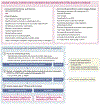Cardiac Amyloidosis Due to Transthyretin Protein: A Review
- PMID: 38441582
- PMCID: PMC11167454
- DOI: 10.1001/jama.2024.0442
Cardiac Amyloidosis Due to Transthyretin Protein: A Review
Abstract
Importance: Systemic amyloidosis from transthyretin (ATTR) protein is the most common type of amyloidosis that causes cardiomyopathy.
Observations: Transthyretin (TTR) protein transports thyroxine (thyroid hormone) and retinol (vitamin A) and is synthesized predominantly by the liver. When the TTR protein misfolds, it can form amyloid fibrils that deposit in the heart causing heart failure, heart conduction block, or arrhythmia such as atrial fibrillation. The biological processes by which amyloid fibrils form are incompletely understood but are associated with aging and, in some patients, affected by inherited variants in the TTR genetic sequence. ATTR amyloidosis results from misfolded TTR protein deposition. ATTR can occur in association with normal TTR genetic sequence (wild-type ATTR) or with abnormal TTR genetic sequence (variant ATTR). Wild-type ATTR primarily manifests as cardiomyopathy while ATTR due to a genetic variant manifests as cardiomyopathy and/or polyneuropathy. Approximately 50 000 to 150 000 people in the US have heart failure due to ATTR amyloidosis. Without treatment, heart failure due to ATTR amyloidosis is associated with a median survival of approximately 5 years. More than 130 different inherited genetic variants in TTR exist. The most common genetic variant is Val122Ile (pV142I), an allele with an origin in West African countries, that is present in 3.4% of African American individuals in the US or approximately 1.5 million persons. The diagnosis can be made using serum free light chain assay and immunofixation electrophoresis to exclude light chain amyloidosis combined with cardiac nuclear scintigraphy to detect radiotracer uptake in a pattern consistent with amyloidosis. Loop diuretics, such as furosemide, torsemide, and bumetanide, are the primary treatment for fluid overload and symptomatic relief of patients with ATTR heart failure. An ATTR-directed therapy that inhibited misfolding of the TTR protein (tafamidis, a protein stabilizer), compared with placebo, reduced mortality from 42.9% to 29.5%, reduced hospitalizations from 0.7/year to 0.48/year, and was most effective when administered early in disease course.
Conclusions and relevance: ATTR amyloidosis causes cardiomyopathy in up to approximately 150 000 people in the US and tafamidis is the only currently approved therapy. Tafamidis slowed progression of ATTR amyloidosis and improved survival and prevented hospitalization, compared with placebo, in people with ATTR-associated cardiomyopathy.
Conflict of interest statement
Figures


References
Publication types
MeSH terms
Substances
Grants and funding
LinkOut - more resources
Full Text Sources
Medical
Research Materials
Miscellaneous

